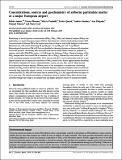Por favor, use este identificador para citar o enlazar a este item:
http://hdl.handle.net/10261/23082COMPARTIR / EXPORTAR:
 SHARE SHARE
 CORE
BASE CORE
BASE
|
|
| Visualizar otros formatos: MARC | Dublin Core | RDF | ORE | MODS | METS | DIDL | DATACITE | |

| Título: | Concentrations, sources and geochemistry of airborne particulate matter at a major European airport |
Autor: | Amato, Fulvio CSIC ORCID ; Moreno, Teresa CSIC ORCID ; Pandolfi, Marco CSIC ORCID; Querol, Xavier CSIC ORCID ; Alastuey, Andrés CSIC ORCID; Delgado, Ana; Pedrero, Manuel; Cots, Nuria | Fecha de publicación: | 15-feb-2010 | Editor: | Royal Society of Chemistry (UK) | Citación: | Journal of Environmental Monitoring 12: 854-862 (2010) | Resumen: | Monitoring of aerosol particle concentrations (PM10, PM2.5, PM1) and chemical analysis (PM10) was undertaken at a major European airport (El Prat, Barcelona) for a whole month during autumn 2007. Concentrations of airborne PM at the airport were close to those at road traffic hotspots in the nearby Barcelona city, with means measuring 48 g PM10/m3, 21 g PM2.5/m3 and 17 g PM1/m3. Meteorological controls on PM at El Prat are identified as cleansing daytime sea breezes with abundant coarse salt particles, alternating with nocturnal land-sourced winds which channel air polluted by industry and traffic (PM1/PM10 ratios > 0.5) SE down the Llobregat Valley. Chemical analyses of the PM10 samples show that crustal PM is dominant (38% of PM10), followed by total carbon (OC + EC, 25%), secondary inorganic aerosols (SIA, 20%), and sea salt (6%). Local construction work for a new airport terminal was an important contributor to PM10 crustal levels. Source apportionment modelling PCA-MLRA identifies five factors: industrial/traffic, crustal, sea salt, SIA, and K+ likely derived from agricultural biomass burning. Whereas most of the atmospheric contamination concerning ambient air PM10 levels at El Prat is not attributable directly to aircraft movement, levels of carbon are unusually high (especially organic carbon), as are metals possibly sourced from tyre detritus/smoke in runway dust (Ba, Zn, Mo) and from brake dust in ambient PM10 (Cu, Sb), especially when the airport is at its most busy. We identify microflakes of aluminous alloys in ambient PM10 filters derived from corroded fuselage and wings as an unequivocal and highly distinctive tracer for aircraft movement. | Descripción: | 9 pages, 9 figures, 2 tables.-- PMID: 20383366 [PubMed] | Versión del editor: | http://dx.doi.org/10.1039/b925439k | URI: | http://hdl.handle.net/10261/23082 | DOI: | 10.1039/b925439k | ISSN: | 1464-0325 |
| Aparece en las colecciones: | (IDAEA) Artículos |
Ficheros en este ítem:
| Fichero | Descripción | Tamaño | Formato | |
|---|---|---|---|---|
| b925439k.pdf | 379,22 kB | Adobe PDF |  Visualizar/Abrir |
CORE Recommender
SCOPUSTM
Citations
54
checked on 03-abr-2024
WEB OF SCIENCETM
Citations
47
checked on 23-feb-2024
Page view(s)
428
checked on 23-abr-2024
Download(s)
685
checked on 23-abr-2024
Google ScholarTM
Check
Altmetric
Altmetric
NOTA: Los ítems de Digital.CSIC están protegidos por copyright, con todos los derechos reservados, a menos que se indique lo contrario.
